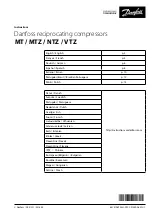
H301/302 HSR Compressors | Rev. 2.2 | 45
1. Check the alignment with one set of bolts removed.
2. Design the mounting bracket indicators for known minimum sag (droop). In
order to correct the
R
readings, the sag must be known.
3. Rotate the driver (both coupling halves) slowly; taking readings at four points
90º apart. The readings will be alike at the four points when the shafts are in
perfect alignment.
4.
Any parallel offset (
R
indicator) should not exceed .005 inches (0.127 mm) total
indicator run out (
TIR
). This corresponds to a .0025 inches (0.064) mm parallel
offset of the shaft center lines. A permissible
TIR
on the angular misalignment
(
A
indicator) is .005 inches (0.127 mm) when referred to a 12-inch (305 mm)
hub diameter.
5.
Write down the final alignment readings (cold, hot and adjusted) in the
and normal operating and maintenance (O and M) records.
6. Check the alignment periodically as part of a routine O and M practice.
7.
Realign the compressor when the parallel offset exceeds the recommended
maximum allowable for current normal (hot) operating conditions.
8. Always verify axial thrust clearance of both the compressor and the driver
after making any alignment adjustment.
Compressor Crankshaft end Thrust Clearance
The compressor crankshaft end clearance design allows limited thrust movement
(float) in an axial direction. This movement accommodates thermal expansion and
limited operational forces. Drive train alignment is often offset cold, so that it can
be more closely aligned in its normal hot operating condition. The driver (either
engine or electric motor) position directly affects the thrust clearance of both the
compressor and driver. A driver placed too close or too far from the compressor
will place increased axial forces on both the compressor and driver thrust
bearings.
The crankshaft end clearance must be in a ‘free floating’ condition for final ‘cold’
and ‘hot’ drive coupling alignment checks.
1. Check thrust clearance with the drive coupling completely assembled and all
bolts torqued to specification.
Consult the driver manufacturer’s manual / data for
crankshaft or rotor end thrust clearances. Electric motors
may have a magnetic center that determines and controls
the axial position of the rotor shaft affecting compressor
crankshaft end clearance during operation.
Complies with ANSI Z535, ISO 3864, OSHA 1910.145 (f) (9)
2. Check the compressor crankshaft end thrust clearance after the alignment
has been completed. The compressor crankshaft must stay, unrestrained, at
its full fore and aft positions during end thrust checks. Fore or aft crankshaft
movement, after releasing the bar, indicates axial spring force in the drive
coupling, due to the driver being too far from or too close to the compressor.
Axial adjustment of the driver’s position is required to correct this condition.
Summary of Contents for H301 Series
Page 1: ...High speed reciprocating compressors H301 and 302 series operating manual GE Oil Gas ...
Page 10: ......
Page 17: ...H301 302 HSR Compressors Rev 2 2 7 ...
Page 18: ......
Page 30: ......
Page 48: ......
Page 61: ...H301 302 HSR Compressors Rev 2 2 51 ...
Page 62: ......
Page 76: ......
Page 98: ......
Page 103: ...H301 302 HSR Compressors Rev 2 2 93 ...
Page 104: ......
Page 114: ...104 Chapter 8 Maintenance Figure 21 Effective rod extension amount pocket is open ...
Page 120: ......
Page 129: ......
Page 130: ......
Page 135: ...H301 302 HSR Compressors Rev 2 2 5 ...
Page 137: ......
















































